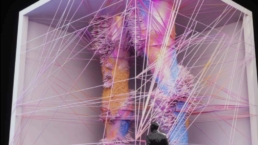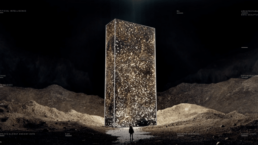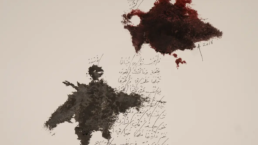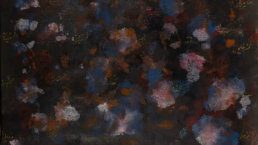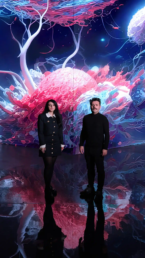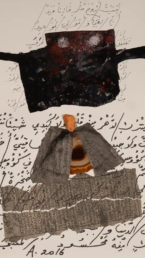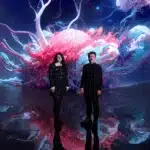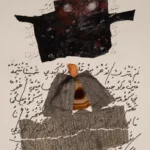EXHIBITIONS | VIEWING ROOM | ART DUBAI
ART DUBAI DIGITAL
01 - 03 MARCH, 2024
FEATURING: OUCHHH & ADONIS
ART DUBAI DIGITAL
As the art world continues to adapt and evolve in the digital and NFT realms, new communities are emerging to support these worlds, involving new creators and stakeholders. In 2022 Art Dubai launched Art Dubai Digital – a new dedicated section of the fair examining the context out of which NFTs, cryptocurrency, video art, and virtual reality (VR) have grown since the rise of digital art in the 1980s and recognising those who are leading the way in the rapidly expanding and developing digital art space.
Art Dubai Digital features a curated section that represents a broad geographic base – including traditional gallery models, digitally native platforms and collectives, and presentations by some of the most exciting and innovative artists working in the digital space today.
“Artificial Neuroorganismic AI Data Sculpture of Humanity by Ouchhh”
Can we create an artistic self-portrait of humanity with AI?
Ouchhh New Media Art Studio, in partnership with Hilton Contemporary (Chicago) at Art Dubai 2024, is proud to present “Human Cell Atlas_Artificial Neuroorganismic AI Data Sculpture of Humanity.” This ambitious project stands at the forefront of new media art, utilizing the largest dataset ever assembled related to the human body. Our installation paints a grand portrait of humanity, not with traditional art mediums but through the lens of advanced artificial intelligence and data sculpture.
This artistic endeavor is rooted in the groundbreaking Human Cell Atlas Project, an international coalition of over 2300 members from more than 1000 institutes across 83 countries. Scientists, biologists, clinicians, and mathematicians have united under this initiative, aiming to map every cell in the human body. This colossal effort serves as the foundation for our art piece, which visualizes and interprets the staggering 37.2 trillion cells that comprise the human organism.
Our process begins with the meticulous analysis of single-cell RNA sequencing (scRNA-seq) data. This innovative technique provides a detailed look at the RNA molecules present in various cell types, such as blood, brain, liver, and skin. Through this process, we can uncover the intricate and often hidden relationships between genes, trace distinct cell lineages, and explore the complex cell populations that form the tapestry of human life.
By employing advanced algorithms like Auto Encoders, PCA analysis, and the tSNE algorithm, we have transformed this immense dataset into a multidimensional, artistic representation. Our piece transcends the boundaries of traditional art and science, offering a unique perspective on the human condition. It is a poetic tale of our shared humanity, sketched with lines of code and torrents of data.
Our sculpture is not just an artistic expression but a confluence of science and art, telling a story of human potential and resilience. As we chart the cell types in the human body across various life stages, we aim to offer a new understanding of health and disease. This project symbolizes a journey through the very essence of what it means to be human, encapsulating the complexity and beauty of our biological makeup.
At Art Dubai 2024, visitors will witness a fusion of art, technology, and biology like never before. The “Human Cell Atlas_Artificial Neuroorganismic AI Data Sculpture of Humanity” is not just an art piece; it is a testament to human innovation and our endless quest to understand ourselves better. Join us at Hilton Contemporary to experience this unparalleled journey through the microscopic universe within us all.
Absolutely, here’s an additional paragraph that seamlessly integrates the impressive accomplishments of Ouchhh studio:
Over the last 14 years, Ouchhh studio has solidified its reputation as a pioneer in the realm of new media art, captivating over 15 million viewers worldwide with its groundbreaking works. Our studio has forged notable collaborations with esteemed institutions such as the Singapore ArtScience Museum, NASA, CERN, and the Mori Art Museum in Tokyo etc… These partnerships reflect our commitment to merging art with science, creating immersive experiences that challenge and inspire. Our creations have been showcased in over 75 countries and cities, earning numerous accolades for their innovation and artistic excellence. This illustrious history of achievement and global engagement sets the stage for our latest masterpiece at Art Dubai 2024, where we continue to push the boundaries of art and technology.
Adonis is internationally renowned as a poet, essayist, philosopher and theoretician of Arab poetics. Referred to as “the greatest living poet of the Arab world” and “the grand old man of poetry, secularism and free speech in the Arab world”, or as « The man who remade Arabic poetry » (Robyn Creswell in The New Yorker, December 2017) he is one of the most influential figures in poetry. He has been writing for more than 75 years and has more than fifty published works in Arabic of poetry, criticism, essays, and translations. Rebelling against the tropes of traditional Arabic poetry to experiment with free verse, variable meter and prose poetry (drawing on Sufism and mysticism), he is responsible for a poetic revolution in the Arab world the scale of which has been compared to that of what T.S. Eliot did for the English poetic canon.
Adonis was born Ali Ahmad Saïd Esber in 1930, in the small village of Qassabin in the coastal mountains of Northern Syria. As a child, he attended the local Kuttab for instruction, reading mainly the Quran, while his father initiated him to classical Arabic poetry. After an encounter with the Syrian president Shukri Al-Quwatli during a visit to his village in 1944, Adonis was granted a place at the French Lycée in Tartus, and, by 17 was submitting poetry under the pen name of Adonis and in so doing unintentionally symbolizing what would become his world view, away from all that’s religious and nationalistic, embracing of all that’s human and universal. He studied philosophy at the University of Damascus in 1951, before serving in the Syrian military. During this time, he was imprisoned for alleged affiliations with the Syrian Social Nationalist Party, and upon his release, fleeing persecution he moved to Beirut in 1956 where his wife, Khalida Saleh joined him a few months later.
In Beirut, he joined the circle of the poet Yusuf al-Khal (1917–87), who has returned to Lebanon in 1953 after an extended stay in the United States and founded the literary journal Shi’r (Poetry), trying to gather the local literary avant-garde around him. When Adonis arrives in Beirut in 1956, he co-directs the journal with al-Khal. This publication, which is dedicated exclusively to the avant-garde, offers a platform not only to recent poetry from the region but also to translations from Western languages, above all from English and French. In addition to editing this journal, Adonis produces his own publications and volumes of poetry, initiating a revolution in the structures and themes of Arabic poetry. In 1960, he spends a year studying in Paris with a scholarship from the French government. In 1961, he publishes Songs of Mihyar the Damascene which is considered to be a turning point not only in Adonis’ writing but in the modernist poetry movement in the Arab world as well. In 1968, he founds his own magazine, Mawâkif (Positions) a unique experience of freedom of speech featuring, alongside with poetry and verses, essays on politics, religion, philosophy, and literary theory, gathering writers from all Arab speaking countries.
In 1971, he receives the Syria-Lebanon Award from the International Poetry Forum in Pittsburgh. This same year, he writes his long poem Tombeau for New York which he considers as an important stage in his life as a poet. He is appointed as professor at the Lebanese University in Beirut and in 1973, he publishes his PhD dissertation, The Fixed and the Dynamic, a synoptic study of Arabo Islamic history, including social movements, literature and theology from the pre-Islamic period through the early twentieth century. In 1980, he teaches as a visiting professor at the Université de la Sorbonne Nouvelle, Paris III, and in 1984, Adonis gives a series of four lectures at the Collège de France titled “An Introduction to Arab Poetics.” In 1986, he moves with his family to the French capital for the long term. That same year, he receives the Grand Prize of the Biennale Internationale de la Poésie in Liège.
Between 1995 and 1997, he is a visiting lecturer at the Institute for the Transregional Study of the Contemporary Middle East, North Africa, and Central Asia, Princeton University. From 1998 to 2000, he spends two years in Berlin as fellow at the Institute for Advanced Studies. From 1995 to 2002 he publishes the 3 volumes of Al Kitab (The Book), his poetry masterpiece.
Adonis’ poetry is translated to many languages, including French, English, Chinese, Spanish, Italian, Swedish, and German, to mention a few. His works in English translation include The Blood of Adonis (selected poems translated by Samuel Hazo), An Introduction to Arab Poetics (essay, Saqi books), The Pages of Day and Night (selected poems translated by Samuel Hazo), If Only the Sea Could Sleep, (selected poems translated by Kamal Bullata, Susan Einbinder and Mirène Ghossein), A Time Between Ashes and Roses (translated by Shawkat M. Toorawa, Syracuse University Press), Sufism and Surrealism (essay, Saqi books), Adonis, selected poems, (translated by Khaled Mattawa, Yale University Press), Violence and Islam I and II, Conversations with Houria Abdelouahed (Polity Books), Concerto al-Quds, (translated by Khaled Mattawa, Yale University Press), Songs of Mihyar the Damascene, (translated by James Kareem Abu-Zeid and Ivan Eubanks, New Directions).
Adonis has won numerous awards, including the highest French honour of Chevalier of the Légion d’Honneur (2012), Commander of the Ordre des Arts et des Lettres (1997), Turkey’s Nazim Hikmet Prize (1994), the Premio Nonino Internazionale, (Italy, 1999), The Bjornson Prize for Freedom of Expression (Norway, 2007), Goethe Prize (Frankfurt, Germany 2011), the Petrarca-Preis (Munich, 2013), the Erich-Maria Remarque Freedom Award (Osnabruck, 2015), Prix Littéraire Prince Pierre-de-Monaco (2016), the US PEN/Nabokov International Literature Lifetime Achievement Award (2017), The 13th Poetry and People Award (Guangzhou, China) 2018.
Adonis has collaborated with several artists, including Mona Saudi, Kamal Boullata, Dia Azzawi and Ziad Dalloul. In the 80’s he started his own experiences with visual art exploring a new artistic and poetic expression, by writing and drawing simultaneously, mixing collages, calligraphy and encres de Chine.
Since then, this visual work has been presented in numerous solo exhibitions in Paris, London, Berlin and in China.
It is important to stress out that Adonis does not consider himself as a painter. For him, this visual work is an extension to his poetry and writings.
Contact Us

